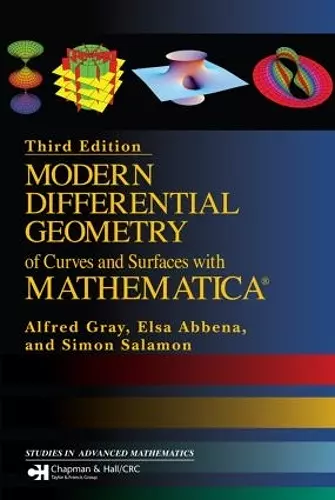Modern Differential Geometry of Curves and Surfaces with Mathematica
Alfred Gray author Elsa Abbena author Simon Salamon author
Format:Hardback
Publisher:Taylor & Francis Inc
Published:21st Jun '06
Currently unavailable, our supplier has not provided us a restock date

This comprehensive guide explores defining and computing geometric functions with Mathematica, focusing on curves and surfaces. It includes numerous illustrations, examples, and miniprograms to enhance understanding of differential geometry concepts.
"Modern Differential Geometry of Curves and Surfaces with Mathematica" is a comprehensive resource that explores the definition and computation of standard geometric functions through the use of Mathematica. This third edition, updated by authors Abbena and Salamon following Alfred Gray's passing, retains Gray's intuitive teaching style while reorganizing the content for clarity. The book effectively separates theoretical discussions from practical Mathematica code, enhancing the reader's understanding of geometric concepts.
The authors delve into significant topics, such as quaternions, and adopt a computational approach that distinguishes this book from typical texts on differential geometry. For instance, while Brioshi’s formula for Gaussian curvature may be complex for manual calculations, Mathematica simplifies these computations, allowing for effective graphing of curvature. Additionally, the book takes advantage of Mathematica's special function library, enabling the definition and visualization of nonstandard spaces of constant curvature through elliptic functions.
With over 300 illustrations, this book not only aids in plotting curves and surfaces but also emphasizes classical differential geometry. It highlights key theorems and includes numerous examples to reinforce learning. Furthermore, the inclusion of 300 miniprograms facilitates the computation and visualization of various geometric objects, making it easier for readers to explore concepts such as curvature and torsion in space. Overall, this book serves as a valuable tool for anyone interested in the intersection of differential geometry and computational methods.
“This is a nicely readable textbook on differential geometry. It offers an outstanding, comprehensive presentation of both theoretical and computational aspects … There are hundreds of illustrations that help the reader visualize the concepts. … It is a nicely written book, strongly recommended to all with an interest in differential geometry, its computational aspects and related fields.”
— In EMS Newsletter, June 2007
ISBN: 9781584884484
Dimensions: unknown
Weight: 1930g
1016 pages
3rd edition